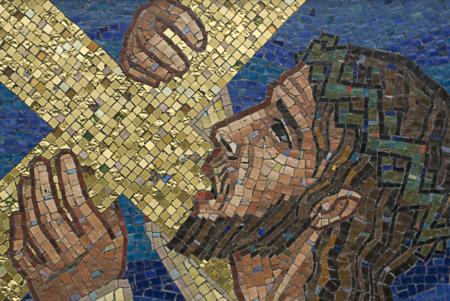The Passion, the Cross and the Stations
One of the most widespread devotions of Lent is the Stations of the Cross. From the time I was a young altar boy I have been walking the stations, kneeling and standing and singing the Stabat Mater while listening to meditations on the way Christ walked to the cross.
That way is a real road in Jerusalem, called the Via Dolorosa or "road of sorrows" from the first days of the Church, as pilgrims went to Jerusalem and tried to literally walk in the footsteps of the Lord. "Come, and follow me," Jesus told his disciples. And so pilgrims took him literally.
The Stations of the Cross in Jerusalem and in your parish Church have changed a lot through the years. Actually, if you searched the scriptural accounts for the story of Veronica and her veil or the three times Jesus falls you would find nothing. These, and many other stories about the Passion of Jesus do not come to us from the Gospels, but from legends which developed parallel to the biblical accounts in the years immediately following the Lord's passion, death and resurrection.
Perhaps the most famous annual celebration of the Stations of the Cross is by the pope in the Coliseum in Rome on Good Friday. Who can forget the last year of Saint John Paul II's life when, too weak to make the short trip to the Coliseum, Pope John Paul sat in his chapel, holding on to the cross as he participated in the Passion for the Lord in the last days of his life.
That is, after all, what the Stations are all about. They are a participation in the Passion of the Lord, and attempt to join our sufferings to his in order to gain the grace to take up whatever crosses God may send us. As Saint John Paul once wrote, the Stations of the Cross represent the "unceasing effort to stand beside the endless crosses on which the Son of God continues to be crucified."
That means that the Stations of the Cross draw us close not only to Christ upon the cross, but Christ who continues to suffer in the poor, the marginalized and anyone who cries out in pain. For if we want to follow the Lord, we need not fly to Jerusalem or travel back in time. He himself told us that he is found in the man who slept on the street outside your Church last night, in the woman whom no one visits in the nursing home or in the prisoner who has been locked away beyond all human contact.
For the cross is the hope and salvation of every broken human heart, of every frightened human being, of every person who stands alone and shivering in a desert of his own isolation. Carrying that cross with Christ, we are given a reminder that we are never alone, we are given "the certainty of the unshakable love which God has for us. A love so great that it enters into our sin and forgives it, enters into our suffering and gives us the strength to bear it. It is a love that enters into death to conquer it and to save us. The cross of Christ contains all the love of God, his immeasurable mercy." (Pope Francis, World Youth Day 2013, Stations of the Cross)
That is why pilgrims sought to make the long and arduous pilgrimage to the Holy Land in the early days of the Church and why, at mid-afternoon or on Friday evenings we gather in the parish church to walk with Jesus and receive the consolation of his blessed Passion, which has redeemed the world.
The Passion. The Cross. That is what Lent is all about.
MSGR. JAMES P. MORONEY IS RECTOR OF ST. JOHN'S SEMINARY IN BRIGHTON.
- Msgr. James P. Moroney is Rector of St. John's Seminary in Brighton.



















